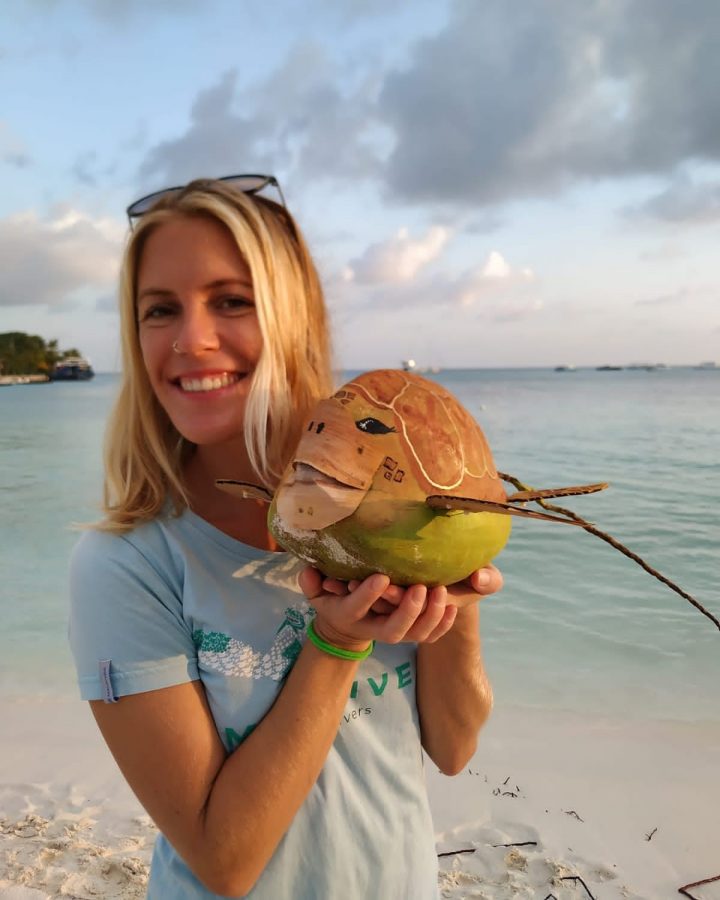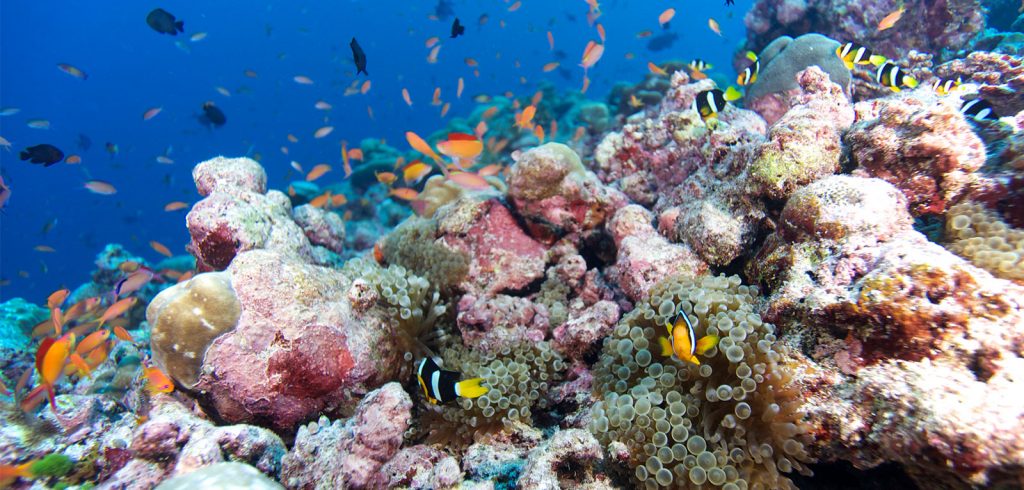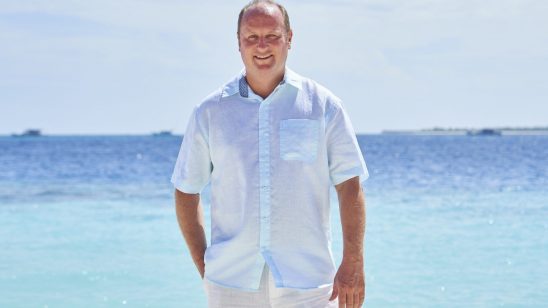
Meet Emily Mundy of the Olive Ridley Project
To mark World Ocean Day on June 8, Hotelier Maldives interviewed Emily Mundy who is a marine biologist with the Olive Ridley Project. She works for Kuredu Island Resort & Spa set on the teardrop island in the Lhaviyani atoll, surrounded by azure lagoons and cobalt Indian Ocean. With 50 dive sites just beyond the white-sand beaches that have thatched garden bungalows and beach villas, this is a diver’s paradise.
HM: Tell me about yourself and what it is like to be a marine biologist? You must have the best job in the world?
My name is Emily Mundy, I’m 33 years old, a British citizen who was born and raised in Zimbabwe, southern Africa. I grew up far from the ocean but always thirsted for it, and I have really plunged in by now working as a marine biologist on a small island surrounded by the Indian Ocean. My job, in my biased opinion, is indeed the best job in the world.
HM: Tell me a bit about yourself and your background, where you have worked?
I studied in South Africa and in my twenties, I traveled the UK, China and Vietnam teaching English, then volunteered in the Gili Islands in Indonesia doing coral restoration. I then worked in the diving industry as a dive master on liveaboards (dive safari boats) in Thailand. That job gave me such valuable experience in water, and I learnt so much about fish life in the tropical Indian Ocean and the coral reef ecosystem, and I fell in love with it!
HM: Why did you decide to become a marine biologist and how you came to be in the Maldives?
During the years of working in the diving industry and volunteering in marine conservation, my eyes were opened to the harmful effects of human activities on ocean ecosystems and marine life. I could not sit by and watch, I felt strongly that I had to get involved and work towards a healthy future that is achievable for all if we protect ocean health and conserve marine life. After completing my MSc in the UK, I got a job as a marine biologist on a different island in the Maldives, however, that did not work out and I left for Australia as I was offered the opportunity to volunteer with a fantastic group that campaigns for marine protected areas, which further developed my skill set. I then returned to the Maldives working first as a Scuba Instructor before I got the opportunity to apply for my dream job with the Olive Ridley Project.

HM: What do you love most about the resort?
The resort is situated on an incredible island where guests can see a baby shark and stingray nursery from shore, watch hunting fish and cruising sharks from the jetty at night, snorkel with green sea turtles in the lagoon, and reef fish on the house reef and even see dolphins swim past through the channel adjacent to the island. It is an island blessed with marine life that is accessible for guests to see, and I think that is special.
HM: What is your most memorable moment under the sea?
That is hard to narrow down to just one. I have been so lucky over the years to snorkel and dive with a range of incredible creatures, but what comes to mind is a morning earlier this year when I was conducting a survey for sea turtles in the lagoon, with guests accompanying me, and we saw a very rare ray called an Ornate Eagle Ray swim calmly beneath us (it was over two meters wide, wing tip to wing tip), shortly followed by a group of at least 10 blacktip sharks swimming together, as well as over eight individual green sea turtles who were not just grazing on seagrass near each other but we watched as a few of them approached and nudged each other, which is not always common to be able to witness with sea turtles! We emerged from the lagoon elated and in total awe of what is right there around the island just below the surface!
HM: What is the resort doing to help the marine environment?
The resort supports the charity that I work for, the Olive Ridley project, and they provide much-needed aid in turtle nesting season by alerting me to nesting females, turtle tracks, and protecting the nests throughout the incubation period, as well as ensuring the hatchlings can make it out to sea undisturbed. The resort also does not allow the touching or feeding of any marine life, which is important in protecting these sensitive animals from even unintended harm. The best course for nature is a natural one!
HM: Can you tell me about the collective conservation efforts by marine biologists in the Maldives and why it is so important?
There are many marine conservation projects operating in the Maldives which provide vital research and learning about marine creatures, care and preservation of populations and education and best-practice guidelines for local people, guests and resorts. I work for a charity protecting sea turtles, however, I also report on coral bleaching in the atoll I work, and I send data and photographs of manta rays, ornate eagle rays and whale sharks to the groups concerned with those species. The marine biologists in the Maldives are not able to fix the issues or reverse the destructive trends themselves, however, we all communicate and share knowledge, advice and aid across the country, so that we can each have a better impact in our particular corner. Many biologists share relevant data with our charity, the Olive Ridley Project, and we are greatly appreciative of that, and reliant on it from areas we are not able to reach.
HM: Can you tell me more about your turtle conservation project?
The Olive Ridley Project protects sea turtles and their habitats in the Indian Ocean. An important aspect of the work is to retrieve ghost nets from the ocean, these are abandoned or lost fishing gear that is still floating through the ocean entangling and harming marine life even though it is no longer being used by fishers. We remove the net, take all the data on it so we can track where it may have originated from, and dispose of it. Sadly, we often find turtles entangled in these nets and in other debris, often a species called the Olive Ridley turtle (hence the name of our charity). Being tangled in a net often leads to external and internal injury, so we rescue the turtles and send them to our very own rescue centre, located on the resort island of Coco Palm in Baa Atoll. We currently have four biologists such as myself in the Maldives with the project, and we also oversee the nesting activity on the beaches of the atoll we are situated in. This includes protecting the nesting female from disturbance, as they are very shy and require darkness and quiet to feel safe enough to lay a nest. We then ensure the hatchling turtles can make it to the sea safely by themselves, without being distracted by lights (which sadly they would follow inland getting lost) and run down the beach without disturbance. Hatchlings need to run themselves from the nest, as it is during this time that they imprint the beach and location which allows them to navigate the oceans throughout their life. Seeing as though survival rates for baby turtles are so low, as little as one out of 1’000 survive to adulthood, this part of the job is important! We also survey by diving or snorkelling to document all sea turtle sightings, and we use photographs of each side of the turtle’s face to identify one individual from another, as they have unique facial scales. We are then able to monitor the populations over time. It also allows for symbolic turtle adoption which, for a donation to us, you can name a wild sea turtle, get a certificate, and perhaps even email updates if your turtle is sighted again! It’s a great source of income for our charity and a lovely eco-friendly gift to get a loved one!
HM: How many species of turtle are there in the Maldives and where are the best places to see them?
Of the seven species of sea turtle in the world, you could see up to five in the waters surrounding the Maldives. The most common being the hawksbill sea turtle, which is found on coral reefs as they feed on sponge, algae, jellyfish and even shrimps which they scrape off the rocks. The other species you could find is the green sea turtle which feeds on seagrass and so inhabits shallow lagoons that have healthy seagrass meadows. If you are lucky you could find a loggerhead turtle or even a leatherback (the largest sea turtle species) swimming by! The last of the five would be the Olive Ridley which we only encounter if they are entangled in ghost gear and have been brought through the Maldives on the ocean currents. For the green and the hawksbill sea turtles, the Maldives provides reefs and seagrass meadows that make up their habitats, and without which they could not survive. The country is also home to some very important nesting grounds, such as Gaadhoo island in Laamu atoll, which is the most significant nesting ground for green sea turtles. The Maldives government protects sea turtles, as green turtles are classified as Endangered by the International Union for the Conservation of Nature, while the hawksbill turtle is Critically Endangered. It is illegal to touch, disturb, hunt, or collect turtle eggs, and this is important in ensuring that current populations do not decline.
HM: Are turtles being threatened in the Maldives due to rising pollution?
Pollution is a threat to sea turtles, as we have documented and removed a large amount of ghost fishing gear since our project began in 2012. Our vets at the rescue centre have also found some sea turtle patients passing plastic which they had eaten out in the ocean before becoming entangled and being sent to the center. Plastic entanglement and ingestion are potentially life-threatening to sea turtles, and debris is unfortunately now a common sighting in all our oceans. We have some exciting excursions to our sea turtle hotspots around the island for both divers and snorkellers. We will also use the platform of World Sea Turtle Day to educate our guests on the vulnerable status of sea turtles throughout the world and to teach the Olive Ridley Project’s code of conduct for swimming with sea turtles. Most importantly, never touch and never ever ride a sea turtle! They are reptiles and do not enjoy our touch, they have nerve endings throughout their shell and can feel everything, but worrying they can absorb products such as sunscreen, soap, sanitiser and bacteria from our hands into their bloodstream which is unhealthy and harmful to them! Always be aware of the turtle’s behaviour and do not disturb their activity, so keep at least 1.5m away, and stay at the side, not above as they may need to come up for air. The calmer, quieter and more respectful you are, the better the encounter with the sea turtle will be!
HM: What can guests do to help marine life while staying at the resort?
While staying at Kuredu Island Resort & Spa guests are encouraged to visit the Marine Biology Centre and join the Kuredu Turtle Search which includes an educational presentation on these wonderfully weird and much-loved charismatic creatures, and then a survey in the lagoon to count, photograph and note the behaviour of our resident green turtles. Guests are also encouraged to pick up a litter bag to put any washed-up debris in as they stroll the beaches surrounding the island, this helps to reduce the plastic waste that ends up in the sensitive ecosystems and animals that we love and protect.
HM: What are the most memorable moments across your career?
I’ll always remember and hold dear the conversations I have with guests who are learning about sea turtles for the first time, they are amazing animals, and I have never met anyone who does not like them! But most of all, it is always fulfilling to see people’s reactions at seeing a sea turtle for the first time, they are often quite emotional and full of awe!
HM: What changes have you seen in the industry during the time you have worked at the resort?
What has been notable is the standards that the guests themselves expect and demand of the tourism industry. People are becoming more educated and aware of environmental issues, and they want to see the industry take them seriously. Of course, there is always more to learn and understand, but it is heartening to see that people really do care.
HM: What hobbies do you enjoy when you are not at work?
We have made use of the island’s paddle tennis court, which is a great game! But mostly days off are for taking some much-needed rest and relaxation, and a day out of the powerful sun! If we are feeling energetic then an occasional outing on the paddleboards, but more commonly I do a sunset walk on the beach to visit the baby sharks.
HM: What steps did you take to become a marine biologist?
University study was key, but it all began with real experience and time in the water working as a dive guide and just looking up and reading about the marine life I was seeing, that was such an amazing education in itself.
HM: What has been your biggest challenge along the way?
Marine biology is a competitive industry and finding paid work is difficult, so not losing hope and staying positive was difficult at times.
HM: What advice would you give to people?
If you love it, do it! Even if you don’t end up working in marine conservation, it is important that as many people are educated and aware of the issues as possible! You can learn so much about the world, life, industry, people and what the future might or should look like, just by studying marine conservation! Learning about it could also steer you towards any number of surprising and unusual places or jobs you never thought of before!

HM: What is the coral like around the island and what coral propagation schemes are there?
We have a long coral reef running along the north of the island, it is shallow on the top reef but drops steeply to very deep depths, and a shallow coral reef at the edge of the lagoon, along the south which is our house reef. Over the years we have seen the decline in coral cover on the reefs due to coral bleaching events, which is caused by ocean temperatures rising too high for too long and the coral consequently losing the symbiotic algae in its tissues which gives it colour, so then appears white, and if sustained then the coral will die. We have also seen the weakened coral colonies then damaged by strong storms and wave action. We do not currently have a propagation scheme on our reefs but are looking into setting one up.
HM: What diving experiences are available on the island?
We offer all levels of diving experiences on Kuredu! For people who have never tried scuba diving before we offer a discover experience, which takes you through the basics of dive theory and then you go for a shallow dive with an instructor to try it out! We then offer the full range of PADI dive courses from Open Water, Advanced and right up to Dive Master, as well as specialties such as enriched air nitrox, and my personal favourite, Dive Underwater Propulsion Vehicle. This is for the advanced divers who want to go further, in stronger currents using a scooter, and in Lhaviyani atoll, this is great for shark viewing, as well as for speeding along feeling like an underwater superhero!
HM: How has the pandemic helped the marine life to flourish with less contact from the outside world has it thrived?
Interestingly, there was not a lot of change that we saw when we returned to work after seven months of lockdown in 2020. At the start, we did see dolphins from the boat more often, and perhaps more lovely sharks during the dives, but the coral health and fish life was not different. The turtles were nervous of people though! It took a few weeks for them to settle and to allow me to approach (never closer than 1.5m) to take the identification photos. I think that tourism, if managed responsibly and sustainably, could be a great preserver of natural ecosystems, as reef and lagoon environments are actively protected from fishing and pollution for the viewing pleasure of guests. In countries where the tourism industry provides so many jobs, it is an alternative to practices such as fishing, farming or other extractive practices which may be unsustainable. Of course, the key is always to manage with sustainability and conservation in mind.





